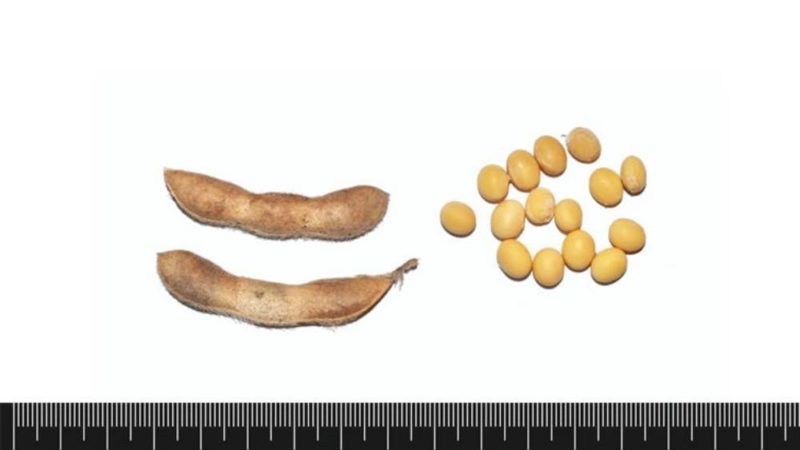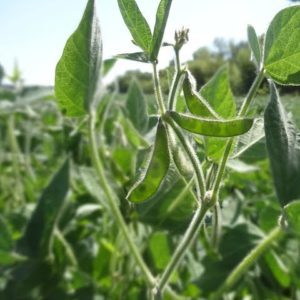Characteristics and description of soybean prudence
Soybeans are the most widespread high-protein and oilseeds in the world. It is used for technical, feed and food purposes. In terms of quality and profitability, it competes with sunflower. In this article, we will tell you in detail about the Prudence variety, its agrotechnical features, cultivation conditions and practical application.
The content of the article
Characteristics of soybeans Prudence
Soy Prudence is a new product from the Canadian company Huron Commodities. This is not a transgenic (GMO soy) variety.
Huron Commodities acquires exclusive rights (patent) for varieties bred in the world's leading universities. Develops and supplies over 20 seeds soybean varieties for an agricultural holding to Japan, Europe and southeast Asia. The most popular and demanded varieties in Russia and the CIS countries are Avatar, Prudence, Strive, Prescot, Connor.
The originator of the variety is the University of Guelph (University of Guelph). Trade representative in Russia - Prograin Ru LLC.
Biological traits
Soybean Prudence is a high-yielding, intensive mid-season variety.
Belongs to the numerous genus of herbaceous flowering plants of the Legume family (Moths). Tribe of flowering crops - Bean. Refers to the type of annual soybeans (cultivated).
Development type - indeterminate (unlimited stem growth).
Stem height - up to 90 cm. Stem erect, dense, slightly pubescent with reddish-brown hairs, not prone to lodging. The leaves are green, slightly pubescent, ovoid, with pointed ends. Leaves are collected in groups of 3-4.
The flowers are small, expressionless, odorless, have 5 petals, collected in clusters, which are formed in the leaf axils.
The pods are pubescent, curved, sickle-shaped, brown in color. Convex in shape. The length of the pod is 5-6 cm. 1-4 round fruits ripen in a box.
The seeds are medium in size, the seed coat is yellow, the scar is light, yellowish.
The flowering and ripening period is early and middle, depending on the region.
With sufficient nourishment, it bushes, with sparse planting it branches.
The root system is powerful, lateral long processes extend from a short main root.
The variety is resistant to fruit cracking, diseases, viruses and cereal pests (ascochitis, rust, fusarium, peronosporosis).
Suitable as a precursor for winter wheat and corn varieties.
The Prudence variety is adapted to all types of soil.
Chemical composition and nutritional value
BZHU - 36.5 g, 20 g, 27-30 g. Calorie content - above 350 kcal per 100 g of seeds.
Reference. Prudence soy protein is similar in biological value to animal proteins, it is well absorbed and excreted by the body.
100 g of the product contains:
- up to 38% protein;
- 17-21% fat;
- up to 20% carbohydrates;
- 27% non-digestible fiber (fiber).
Essential fatty acids nourish tissues, prevent inflammation, and support the heart and blood vessels. In soy beans Prudence contains vitamin F, a complex of unsaturated Omega-3 and Omega-6 acids:
- linoleic;
- oleic;
- linolenic.
The vitamin composition provides the body with energy, mobilizes protective functions, and supports the functioning of organs and systems.

100 g of mature seeds account for:
- 0.15 mg vitamin A;
- 0.5 mg vitamin D;
- 0.11 mg vitamin E;
- 0.34 mg vitamin C.
B vitamins:
- up to 1 mg of thiamine;
- 0.25 mg riboflavin;
- more than 2 mg of niacin (vitamin PP);
- 1.8 mg pantothenic acid;
- 200 mcg folic acid
- 0.9 mg pyridoxine.
Prudence soybeans contain 5-6 times more vitamin B2 (riboflavin) than wheat grains.
The composition contains essential and nonessential amino acids - regulators of hormonal levels, metabolism and central nervous system processes:
- lysine - 2.2 g;
- arginine - 2.6 g;
- leucine - 2.6 g;
- isoleucine - 1.8 g;
- phenylalanine - 1.7 g;
- threonine - 1.3 g;
- valine - 1.8;
- histidine - 0.8 g;
- cystine - 0.5 g;
- meteonin - 0.46 g;
- tryptophan - 0.43 g
The minerals potassium, calcium, phosphorus strengthen the connective and bone tissue, activate the work of the NA and the brain, and have a beneficial effect on the endocrine system.
Application
The main purpose of Prudence soy is the food industry and culinary.
It is a useful substitute meat, cheese and milk. Fans of East Asian cuisine, vegans and vegetarians are actively using soy products that have appeared on domestic shelves in the last decade.
Most popular products:
- soy flour;
- butter, milk, tofu (cottage cheese);
- soy mayonnaise, sour cream, cream;
- meat (processing of soybeans);
- Korean gochujang pasta (hot seasoning with pepper);
- Japanese thick miso pasta with rice, wheat;
- Korean asparagus (fibers marinated with spices);
- soy sauce is especially popular as a dressing for rolls, stews, fried vegetables and salads.
Soy flour is added to breads, cakes and cakes, pastries, sausages and sausages. The meat from the crushed beans is used to make cutlets, meatballs, schnitzels and pates. These foods are considered safe for diabetics.
For children with allergies, soy products are used to make infant formula, coffee drinks, yoghurts, chocolate and chips.
It is interesting! In Japan, medicines for diabetes mellitus based on soy extract - touchi - are recognized and confirmed by state quality certificates.
Technical Uses of Prudence Soybeans

From the residual products after the process of refining and pressing the oil produce:
- soap and cosmetics;
- varnishes and paints;
- concrete;
- solvents;
- plastic, oilcloth;
- linoleum;
- lubricating oil for machines.
The Chinese make yarn from waste from the production of tofu cheese. Soy silk is a raw material for hats, sweaters, socks and textiles.
In animal husbandry and agriculture
Oilcake, meal, aboveground part - nutritious feed for animals. Prudence soybean meal contains up to 38% crude protein and more than 5% fat.
For feeding the calves, a mixture of oil cake, soy flour and mixed feed is used. Nutritional value is not inferior to whole milk.
The beveled aboveground part is equally appreciated fresh and in silo complexes.
Important! In the leaves and stems of the Prudence variety, carotene, protein and calcium are 3-4 times more than in cereals. And hay is equivalent to clover.
Soybean Prudence is sown as green manure - a green "filler" of soil microflora with assimilable nitrogen. In addition, after harvesting, the field remains clean and free of weeds.
Prudence Soybean Agricultural Engineering

The maximum seeding rate of the Prudence variety is 72 kg per 1 ha.
Average consumption per 1 m² is up to 40 pcs. seeds, per running meter - up to 16-20 pcs. seeds.
The optimal planting density is 400-600 pcs. per 1 hectare, depending on soil and air moisture, sowing time, row spacing.
Sowing is carried out in the last decade of April - early May. Narrow-row and wide-row methods are used. Row spacing - 12.5 cm, 15 cm, 30 cm, 45-50 cm.
The growing season is 95-105 days, depending on the region and the amount of precipitation.
The powerful initial development of the seedlings is noted. Two weeks after sowing, the shoots rise by 25-30 cm. By mid-July, a tall bush grows.
Harvest at the end of August. The yield of Prudence soybeans is from 25 to 29 kg / ha.
Protection
According to the cultivation technology, it is obligatory to treat with herbicides "Pivot", "Centurion", "Harmony" in order to suppress weeds.
To protect crops, a mixture of herbicides with surfactants is used.For example, seedlings are treated with a mixture of "Fabian" and "surfactant Adyu" during the period of weed cotyledons (quinoa, sow thistle, ragweed). Before germination, the fields are treated with herbicides based on "Glyphosate" (a systemic preparation against perennial weeds).
Treatment with fungicides "Kolosal Pro", "Benorad" and others is recommended against fungal diseases and spotting.
Fertilizer
Prudence soy is fed in accordance with the type of soil and acidity according to agrochemical cartograms.
It is recommended to make phosphorus fertilizers:
- in the southern regions - 30-50 kg per 1 ha;
- for central and northern areas, the dosage is increased to 80-90 kg.
Nitrogen is applied only on poor and heavy soils.
Potassium fertilizers are used at the rate of 50-60 kg per 1 ha.
It is important to treat the seeds before sowing with nodule bacteria (Nitragin) and micronutrient fertilizers with a high content of molybdenum (ammonium molybdate). The approximate consumption is 150 g per 1 ton of seeds.
Growing regions
For conditions of northern latitude, breeding of breeding soybean varieties is carried out in Canada, Sweden and Germany. Samples of varieties (more than 7 thousand specimens) are in the All-Russian Research Institute named after N.I. Vavilov.
In the North-West region of Russia, it is recommended grow early ripening varieties of soybeans Kasatka, Svetlaya, Eldorado of domestic selection (State Institution Ryazan NIPTI and Siberian Research Institute of Feed).
The mid-early Prudence variety is recommended to be grown in the southern regions and the middle lane. The culture is not afraid of dry summers, it is not prone to lodging.
Under the conditions of the Black Earth Region, soybeans ripen within 105-110 days from the moment of planting.
Soybean Prudence is also cultivated in warm steppe regions, where the humidity level is average.
In temperate climates, it is preferable to sow an early ripe variety of the same Canadian selection - Connor.
conclusions
The Prudence soybean variety is adapted to almost all climatic zones, manages to ripen even in the northern regions. The growing season adapts to the local climate. In agriculture, soybeans are valued as a fodder crop and green manure, a precursor of cereals. Grown in large agricultural communities and small farms. The variety is 100% profitable and high yielding.
Prepared soy products are a complete and safe substitute for animal protein for athletes, vegetarians, children and people with diabetes.